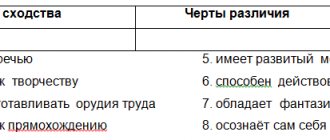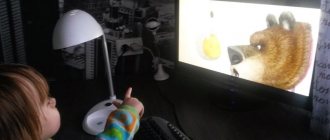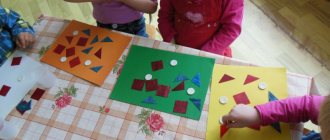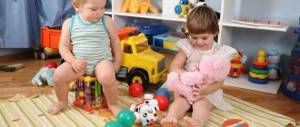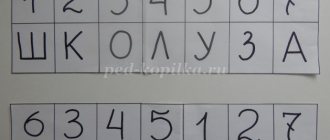Books about trash? Could this be interesting? And how! Thanks to garbage, we know the history of our ancestors - only waste buried deep in the ground has survived to our time. Garbage helped humanity develop - many engineering structures were invented precisely because of it. By recycling waste, astronauts on the ISS receive clean water. Garbage is as much a part of the ecosystem as the sun, water and plants. It’s best to start studying this fascinating topic with the book “The History of Garbage” by the Italian author Mirko Maselli, which was published recently by the Meshcheryakov Publishing House.
Illustration from the book “The History of Garbage”
History of garbage. From ancient waste to plastic recycling
Together with the author, we will go on a historical journey - to the first city landfill (Crete island, 3000 BC), to the caves of primitive people, to Ancient Greece and the Roman Empire, where you can see the first public utilities in human history. “There are different types of work - some of a higher, others of a more urgent nature” - perhaps Aristotle said this about slaves collecting dung.
Illustration from the book “The History of Garbage”
During the Middle Ages, the garbage situation worsened. There was complete dirt and unsanitary conditions around, city residents relieved themselves right on the streets, animals slept in the same room with people. Chronicles of those times tell of such high piles of organic matter outside the city gates that during the war, invaders easily climbed them to the walls. The rules of hygiene were completely alien to the medieval population. Water for washing and drinking was drawn from the same rivers where the slops were poured. Some preachers even declared that bathing was a sin! It's no wonder the world has been gripped by plague.
Only after a third of the world's population died from the plague did people realize that something had to be done about garbage. True, in a rather strange way. Rich people surrounded themselves with art and beauty, enjoying the illusion that external gloss and beauty would obscure the ubiquitous dirt. A fashion arose to move to country residences along with the entire aristocratic court, thus leaving the city with its population and all its garbage to the mercy of fate. Maselli talks about the Milanese "navazza", the Parisian "tombro" and the Roman "spurgo" - urban cleaning services - created at that time.
Illustration from the book “The History of Garbage”
The Industrial Revolution added even more waste. The incineration plants caused far more harm than good. After plastic began to spread across the earth, landfills grew tenfold, as the garbage was no longer biodegradable. Nowadays, the problem of garbage is more relevant than ever - we need to learn how to sort, reduce and recycle it. In the last chapter, the author talks about the importance of caring for the environment. Each of us can refuse plastic bags and go to the store with an eco-bag. And think about separate waste collection, although in Russia there are fewer opportunities for this than in Europe. But another book will better tell about environmental problems in the present time.
Circle work on ecology for children 3-4 years old “Young ecologist”
Circle work on ecology for children 3-4 years old “Young ecologist”
Explanatory note
Previously, when the population was relatively small and every person was in constant contact with nature, environmental laws were learned by people in their everyday life. In the second half of the twentieth century, the bulk of people concentrated in cities and lost touch with nature. As a result, their behavior changed: they began to take from nature everything that seemed necessary to them, without giving anything in return.
Relevance of this program
is that environmental upbringing and education of children is an extremely important problem of the present time: only the ecological worldview and ecological culture of living people can lead the planet and humanity out of the state in which it is now.
Preschool childhood is the initial stage of the formation of a person’s personality, his values, orientation in the world around him. During this period, a positive attitude towards nature, towards the “man-made world”, towards oneself and towards the people around us is formed. The main content of environmental education is the formation in a child of a consciously correct attitude towards natural phenomena and objects that surround him and with which he becomes acquainted in preschool childhood.
Nature is an inexhaustible source of spiritual enrichment for children. They are constantly in contact with nature in one form or another. They are attracted to green meadows and forests, bright flowers, butterflies, beetles, birds, falling snow flakes, streams and puddles. The infinitely diverse and colorful world of nature awakens children's natural interest and curiosity, touches their feelings, excites their imagination and influences the formation of their value orientations. A child who loves nature will not mindlessly pick flowers, destroy nests, or offend animals.
The impressions of our native nature received in childhood are very vivid, memorable for a lifetime and often influence a person’s attitude towards nature.
The novelty of this program is
is that it covers different aspects of environmental education for preschool children.
The program provides not only environmental education for preschool children, but also motivation to develop children’s skills to provide all possible assistance to our nature. This program includes the development of children’s skills in setting up and conducting simple experiments.
For example, growing seedlings for flower beds in a kindergarten. Thanks to the inclusion of children in the development of this educational program, preschoolers receive environmental knowledge, they develop observation skills, a sense of empathy, the ability to see beauty in nature, and the ability to provide all possible assistance to nature. Personal qualities such as kindness, responsibility, hard work, independence, and the ability to work in a team are fostered.
The educational subject environment is used for educational and recreational purposes, to develop children’s work skills and communication with nature.
Club schedule: 1 time per week, in the afternoon, in accordance with the approved schedule of organized educational activities.
The main purpose of the circle's work
— to form in children elements of environmental consciousness, the ability to understand and love the world around them and nature.
The work of the circle is designed to solve the following problems:
- Bring to the understanding that adults and children are also part of nature;
- Fostering a desire to take care of your health;
- Show the importance of natural resources (water and air) in human life;
- Foster a careful, economical attitude towards natural resources;
- Bring children to a conscious understanding of the value of nature;
- Nurturing correct behavior in nature.
To work on the formation of moral and environmental education of preschoolers, a long-term plan for working with children was developed
- Visual methods:
- excursions, targeted walks;
- observations;
- showing fairy tales (teacher, children);
- examination of book illustrations and reproductions;
- conducting didactic games;
- Verbal methods:
- reading literary works;
- conversations with elements of dialogue, summarizing the stories of the teacher.
- Game methods
:
- conducting a variety of games (sedentary, role-playing, didactic, dramatization games, etc.);
- asking riddles;
- Practical methods
- organizing children's productive activities;
- design of a herbarium of plants and fruits;
- production of fairy tales, excerpts from literary works;
- making visual aids with children.
When building the work system of our circle, we paid special attention to the following main directions
.:
- The educational and entertainment direction aims to introduce children to the components of living and inanimate nature, the influence of human activity on these components in a playful and entertaining way.
- The practical direction is the study of flora and fauna related to practical matters (feeding birds, planting flower beds, etc.).
- The research direction is carried out within the framework of productive activities (excursions, observations, experiments).
To sum it up
Open classes, gaming competitions, quizzes, exhibitions, and photo exhibitions are held.
Long-term work plan for the project 2020 – 2020 academic year
Date
topic
tasks
content
September 1 week
"Flowers on the site in autumn"
To consolidate children's knowledge about autumn garden flowers: differences in appearance. Clarify children's ideas about gardening in the fall. Activate dictionary
Making riddles, playing the “Guess the Description” game, experimenting: “Plants breathe easier if the soil is watered and loosened” Collecting and drying autumn leaves “Autumn Palette”
2 week
“Autumn is a storehouse of harvest”
Strengthen children's knowledge about vegetables and fruits. Clarify children's knowledge about caring for vegetables. Cultivate hard work.
Reading poems “Hello, autumn!” E. Blaginina, conversation “What grows in the garden?” Memorizing physics lessons “We chop cabbage...” Didactic game “Find out the taste”
3rd week.
What cures us for colds
Clarify children's knowledge of medicinal herbs, the benefits of onions and garlic. Develop cognitive activity.
Examining medicinal plants, asking riddles, observing.
4week
"Good, good sun"
Clarify children's knowledge about the sun in autumn. To develop the ability to determine the weather by signs.
Experimentation: “Palms” Present. Game "Seasons"
October 1 week
"Tell Piggy about houseplants"
Clarify children’s ideas about plants in the group and the living conditions necessary for them. Introduce new plants. Teach to recognize and name parts of a plant (root, stem, leaf, flower
Game “Find the plant”, physical education, didactic game “What plant did Piggy hide behind?”; experimentation: “What plants need to grow.”
2 week
"Autumn Tree"
To develop children’s ability to observe natural phenomena, analyze and draw conclusions about certain relationships and patterns.
Unconventional drawing technique: blotography. Didactic game “Find the piece of paper I’ll show you”
3week
"Pets"
To form in children generalized ideas about domestic animals: how to care for them, what benefits they bring, what conditions are needed for life.
Conversation, educational game "Who loves what", board game "Animals"
4week
"Rain, rain...
Develop children's ability to observe seasonal phenomena and their changes. To develop the ability to identify the characteristic signs of autumn and summer rain.
finger game "Rain"
November 1 week
"Sparrow"
Introduce children to wintering birds: sparrows. (Check with the children how changes in nature affected the sparrow’s life). Develop an interest in bird watching.
Outdoor game “Who lives in the house?” Finger gymnastics “Rooks”; Speech game “Who is this?”
2 week
“Titmouse holiday - November 12”
To form in children a desire to treat living nature kindly. Learn to organize your own feeding of birds regularly.
Conversation “Guess which bird”, observation, use of literary words, sub. game "Fox and Birds"
3 week
"Wild Animals in Winter"
Continue to develop knowledge about forest inhabitants. To develop in children ideas about the sequence of events in the life of forest animals.
Reading poems, sub. game “Hares and the Wolf”, conversation, “Find Mom” - did.game.
Week 4.
"Snowflake"
Develop the ability to observe seasonal phenomena and their changes, attention and memory, and see the beauty of nature.
Observation, conversation, reading educational stories, experimentation: “Acquaintance with the properties of snow”
December 1 week
Christmas tree-green needle
Introduce children to the concept that cones contain the seeds of coniferous trees. To develop children’s ability to distinguish between a spruce and a pine cone. A.
Observation, conversation, game “Find by description”, “Decorate the Christmas tree”
2 weeks
"Clouds floated across the sky"
Expand children's understanding of inanimate natural phenomena: tell children what types of clouds there are. Development of observation skills.
Conversation “What types of clouds are there”, observation, use of literary words; experimentation: “The wind blows, the boat floats”
3 week
"Snow Round Dance"
Continue to teach children to observe natural phenomena: snowfall and see the beauty of the world around them.
Observation, looking at the painting “Winter”, drawing “Snowflakes”
4 week
“Winter beauty – spruce and pine”
Introduce the desire to enjoy the smell of pine wood. To promote the development of the ability to name the characteristic features of the structure of spruce,
Game surprise moment, compiling a descriptive story about spruce and pine based on the plan,
game - imitation “Collect cones,
January 1 week
Short-term project “Who flies in a white flock and melts like a cool star?”
Develop a realistic understanding of inanimate nature; consolidate knowledge that water can be in a solid state (snow, ice). Introduce the properties of snow
Experimenting “Snow melting”, “Turning water into ice”, “Is it possible to eat snow” using artistic words. Reading E. Blagin’s “Snow-Snowball”, “Me and the Snow” by Druzhinin, etc.
2 week
"Bird Life in Winter"
Teach children to look at birds, distinguish them by size, plumage color, and sounds made. Introduce them to their names.
Conversation, game “Feed the bird”, did. game “They fly away - they don’t fly away”, listening to the voices of birds
3 week
“Moroz is an amazing artist”
Arouse children's interest in winter natural phenomena. Develop visual observation, the ability to notice unusual things in the world around you and the desire to reflect what you see in your work. Develop imagination and creativity.
Making riddles, observing while walking, using literary words, practical work
February 1 week
“Growing onions in the window”
Arouse interest in growing a vegetable garden in a window, a desire to observe changes in the bulbs. Learn to create an experience situation
Conversation with elements of labor, experimentation
2 week
"Wild animals in the forest in winter"
To contribute to: enriching and deepening children’s knowledge about wild animals in winter, developing the ability to establish connections between winter conditions and the behavioral characteristics of animals.
Conversation about squirrel, hedgehog, hare, fox, bear, game “We are little bunnies”, game “Whose shadow”
3 week
"Laboratory of Good Deeds"
To form the concept of kindness, the habit of doing good deeds; cultivate interest in experimental activities; analyze phenomena, draw conclusions; develop cognitive interest, logical thinking, and speech of children; bring a feeling of joy to children
Experiments with water, air, games with soap bubbles, conversations about good and evil.
4 week
"Observing Seasonal Changes"
form ideas about changes in nature; learn to distinguish the characteristic signs of the end of winter (the first drop); consolidate the ability to perceive a poetic description of winter.
Use of artistic words; Outdoor games: “Sly Fox”, “All Year Round” - board game
March 1 week
"Zemelushka winter"
Promote moral development, humane attitude towards nature.
Round dance “Chernozem Earthling”; viewing the presentation “How they used to care for the land”; game “What Animals and Plants Talk About”; productive activity “Planting peas”
2 week
"Planting Onions"
Form the foundations of research activities; to clarify children’s ideas about onions as a vegetable from which green onions can grow. To consolidate knowledge about the needs of plants for soil, water and light.
Game character - grandfather Lukyan doll, looking at illustrations “Stages of onion growth”; planting onions.
3 week
Methodological development on ecology
S/r game “Picnic”
Introduce children to the role-playing game “Picnic”; talk about the rules of behavior in the forest
Examination of the poster “Take care of nature”; obstacle course; breathing exercises; listening to the sounds of nature; picnic in nature
4 week
"Experiments with water"
Continue to identify the properties of water, form ideas about its properties through research activities
D/i “What can happen?”, experimental activity “Properties of water”, “Absorbs or does not absorb”, “Mixing water with liquid soap”; game "Soap bubbles"
April 1 week
"Ladybug"
Teach children to be attentive to the world around them. Cultivate interest in natural phenomena, clarify ideas about the external features of the bug.
Watching a ladybug, applique.
2 week
"Bugs"
Expand knowledge about nature conservation. To instill in children an interest in all living things and a caring attitude towards nature.
Making riddles, “Guess what kind of insect”, sculpting “green caterpillar”
3 week
"Feathered Guests"
To help generalize ideas about birds in the spring: changes in their behavior - basking in the sun, in trees, chirping, nesting, hatching chicks, etc.; cultivate curiosity and a desire to care for birds.
Conversation, making birdhouses, watching birds in the kindergarten area, looking at illustrations (different types of nests, the appearance of chicks, etc.), “Find out what kind of bird it is by its voice”-game. Application “Birds at the feeder”
4 week
"Sorceress Spring"
To consolidate children’s ideas about spring and the characteristic features of this time of year. Draw children's attention to the first signs of spring .
To develop children's interest in living nature and emotional responsiveness.
Conversation, artistic word, fabric applique “Meadow of Flowers”
May 1 week
NOD “Natural phenomena in spring”
2 week
“What are clouds, rain, thunderstorm?”
Give the concept of water evaporation, cloud formation, and electrical discharges in an accessible form. Introduce children to the rules of behavior during a thunderstorm.
Observation, looking at illustrations, reading.
3 week
"Sand Fantasies"
Expand children's horizons: Consolidate knowledge about the properties of sand. Develop imaginative and logical thinking. Develop tactile sensitivity and fine motor skills of the hands. Enrich the emotional sphere of children
Finger gymnastics, playing with sand, experimenting: “why does sand fall out.”
4 week
Ecological trail
Develop observation skills
Excursion, viewing the inhabitants of the trail, reading the poem “Take care of nature.” catchy game “Run once, three times to the tree”
The student must
KNOW
Rules of behavior in nature. Plants and their characteristic features. Main characteristics of wild and domestic animals. Bird species in your area.
HAVE A VIEW.
About migratory birds. On the dependence of changes in living nature on changes in inanimate nature. About nature conservation. About the most characteristic signs of different seasons and natural phenomena. About the importance of nature in human life, caring for the environment and the consequences of environmentally illiterate behavior in nature.
BE ABLE TO
Follow the rules of behavior in nature. Provide care for plants in a corner of nature.. Provide care for plants in flower beds. Provide assistance to the surrounding nature (feeding birds in the winter on the site, removing garbage, making natural signs). Making crafts and panels from collected natural materials..
Diagnostics on environmental education.
1.Has an idea of the plant world, names several species of plants. 2.Has an idea of the animal world, names representatives of the animal world. 3.Has an idea about medicinal plants, name 2-3 medicinal plants,
4.Has an idea about the forms and types of water, its properties, names the inhabitants of reservoirs
5.Has an idea about the rules of behavior in nature 6.Has an idea about natural phenomena, their properties, meaning 7.Has an idea and skills in caring for indoor plants
Assessment of the level of development: 1 point - does not name or names 1 sign, type 2 points - names independently or with the help of an adult 1 or 2 types, signs, properties 3 points names independently 2-3 types or phenomena, properties
From 21 to 15 - high level
From 15 to 7 - intermediate level
7 to 0 - low level
Bibliography:
- Nikolaeva S.N. Young ecologist: Program for environmental education of preschool children / S.N. Nikolaeva - M.: Mozaika-Sintez, 2002.
- Environmental education of preschool children: A manual for preschool education specialists / Compiled by Nikolaeva S.N. - M.: LLC "- 1998.
- Nikolaeva S.N. Methods of environmental education in kindergarten: Working with children of middle and senior groups of kindergarten: A book for kindergarten teachers / S.N. Nikolaev.- M.: Education - 1999
- N.G. Kalegina “Work experience in environmental education of preschool children” Book House Kazan-1994
- “The world around us in didactic games for preschoolers”, Moscow 1992 Artemova L.N.
- “Education of ecological culture in preschool childhood”, Moscow 1995 Nikolaeva S.N.
- “Educational games for children of primary preschool age”, Moscow 1991 Boguslovskaya Z. M., Smirnova E. O.
- Grizik T. Exploring the world. – M.: Publishing house “Education of a preschool child.
Garbage revolution. A double-edged battle
The book “The Garbage Revolution,” published by Walking into History in 2020 and becoming a bestseller, talks about what components our things are made of. What happens to the garbage we throw away every day? And how do you eat your own spoon for lunch?
The twentieth century became the century of consumption. We buy unnecessary things, then throw them away, polluting the environment more and more. But sometimes the world can be changed for the better just by changing your habits. The author of the book, Erica Fyvie, tells how exactly the world of things around us works, where we get water, clothing, food, books and mobile phones. The book provides simple tips on how to improve the environment. For example, use reusable lunch containers, do not buy water in a plastic bottle, refuse disposable tableware, and properly dispose of electronics. And also pay attention to the number of things we buy - do we really need all of them?
Illustration from the book “Garbage Revolution”
Introducing children to nature in kindergarten in a playful way
All children love to have fun. The teacher must make sure that it is also useful and educational, because games sometimes provide more development than smart books and trainings. If there are various trees on the territory of the kindergarten, then you can ask the children to use a leaf to identify the tree from which it fell.
Thematic games are usually selected for children in groups. For example, lotto from cut pictures, where you have to select objects (leaves, fruits, animals) that belong to the same systematic group. Or you can identify 4 seasons for the children and introduce them to the weather conditions inherent in each of the times: raindrops, snow, rainbows, cold winds. Of course, it is worth adding pictures of insects and animals to this game - let the children know that insects do not fly in winter because they sleep.
To get acquainted with the phenomena of nature and its creations, you can conduct verbal quizzes. For example, by definition, name an animal or say when there is snow, rainbow, thunder. Children can imitate the voices of animals: squeak like mice; bark like dogs; moo like cows, and the teacher must guess who is in front of him. The game will turn out to be even more educational if the kids begin to support their sounds with gestures or use them to show those animals that do not make typical sounds.

